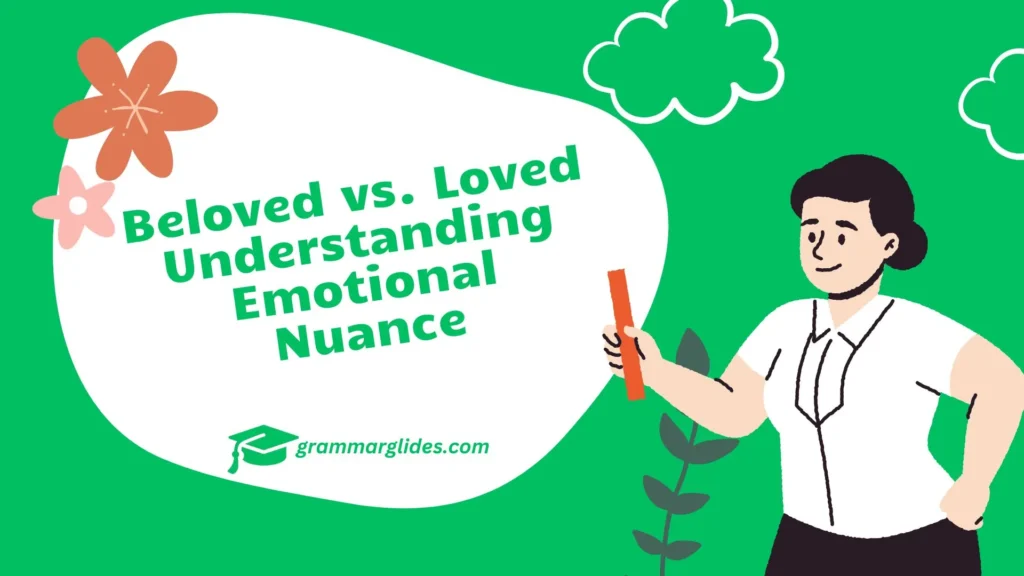“Beloved and loved may seem similar, but their emotional depths set them apart.”
Language is a powerful tool for expressing emotions, and subtle differences between words can profoundly affect their meaning. Among the many emotionally charged words in English, “beloved” and “loved” stand out as carriers of deep affection. While these words might appear interchangeable at first glance, their nuanced meanings convey different intensities of emotion.
Understanding these subtle distinctions not only enhances communication but also deepens our emotional expressions, enabling us to convey precisely how we feel. In this post, we will explore the emotional depths of “beloved” and “loved,” their historical and cultural roots, and how to use them effectively in different contexts.
Join us as we dive into the fascinating emotional connotations of “beloved” and “loved,” learning how each word resonates uniquely and elevates our language.
Overview
“Beloved” and “loved” are both terms of endearment that express affection and care. However, they differ significantly in emotional intensity and contextual usage. While “loved” often denotes a general or everyday kind of affection, “beloved” carries a sense of uniqueness, reverence, and profound emotional connection. In this post, we will explore their meanings, historical significance, and cultural implications through examples and scenarios. By understanding these distinctions, you’ll learn how to use both words effectively to express heartfelt emotions.
Understanding Emotional Depth
Emotional Connotations
The word “loved” is versatile, often used to describe a wide range of affections—from familial bonds to friendships. For example, saying “She is loved by her friends” conveys warmth and care but remains neutral in intensity. In contrast, “beloved” suggests a special, almost sacred bond. Consider the phrase “He is my beloved.” This expression elevates the emotional significance, portraying a deep and cherished connection.
Intensity and Depth
Exploring the emotional depth of these words reveals their differences in intensity. “Loved” can signify casual affection or deep emotional bonds, depending on the context. However, “beloved” inherently implies profound reverence. For instance:
- “The teacher was loved by her students” reflects general admiration.
- “The teacher was beloved by her students” implies deep respect and adoration.
These subtle differences show how word choice impacts emotional depth and tone.
Exploring Intensity
“Beloved” vs. “Loved”

- Casual Context: A child might say, “I love my dog,” expressing affection. In comparison, describing the dog as “my beloved companion” emphasizes the emotional importance of their bond.
- Romantic Relationships: In everyday usage, one might say, “I loved her smile,” indicating appreciation. However, calling someone “my beloved” conveys an irreplaceable emotional connection.
- Cultural Expressions: “Loved ones” is commonly used to describe family or close friends. “Beloved,” however, often appears in memorials or literary works, reflecting a deeper, more enduring affection.
Defining the Unique Intensity of ‘Beloved’
“Beloved” carries cultural and historical weight, often appearing in poetry and literature to denote a cherished figure. For example, in Toni Morrison’s novel Beloved, the word represents more than affection; it encapsulates loss, memory, and redemption.
Historical and Cultural Roots
The origins of “beloved” lie in Old English, where it combined “be-” (an intensifier) with “lufian” (to love). Over time, its usage evolved, becoming associated with profound emotional connections. In contrast, “loved” retained its broad applicability, suitable for both mundane and significant contexts.
Emotional Weight
In modern usage, “beloved” often appears in formal or poetic settings. Consider a eulogy: “She was beloved by all who knew her” carries a weight that “loved” does not. This demonstrates how “beloved” conveys an elevated emotional resonance.
Contextual Usage
When to Use ‘Beloved’
“Beloved” is ideal for expressing deep affection in formal, literary, or emotional contexts. For example:
- A wedding vow: “You are my beloved, my partner in life.”
- A tribute: “Our beloved leader inspired us all.”
Subtle Differences
While “loved” is appropriate for casual settings, “beloved” adds gravity. Use “beloved” when you wish to emphasize uniqueness and profound affection.
“Early This Morning vs Earlier This Morning” Key Usage
Expressing Deep Affection Through Language
Language and Emotions
The power of words lies in their ability to convey nuanced emotions. Choosing between “beloved” and “loved” allows you to tailor your expression to the depth of your feelings.
Examples and Anecdotes
- A child’s letter: “I love you, Mom,” versus “You are my beloved mother.” The latter conveys deeper reverence.
- A romantic poem: “My beloved, you are the light of my life,” emphasizes passion and singularity.
- A public tribute: “He was loved by his community” versus “He was beloved by his community.” The second suggests profound admiration and loss.
The Nuanced Usage of ‘Loved’ in Everyday Language
Everyday Contexts
“Loved” is commonly used in everyday language to express affection without overemphasizing emotional depth. For instance:
- “She loved her morning coffee” reflects routine pleasure.

- “He loved spending time with his family” conveys warmth and joy.
Cultural and Social Implications
In modern culture, “loved” serves as a flexible term suitable for various relationships and situations, from casual to intimate.
‘Beloved’ in Literature and Culture
Literary Significance
Authors often use “beloved” to evoke timelessness and emotional resonance. For example, Shakespeare frequently employed the term in his sonnets to describe idealized love.
Cultural Impact
“Beloved” appears in cultural and religious contexts, symbolizing divine or eternal love. For instance, the phrase “God’s beloved” conveys a profound spiritual connection.
Historical References and Modern Examples
Historical figures like Princess Diana were often referred to as “beloved” due to their widespread admiration. Today, the term remains significant in eulogies, memorials, and literature.
Practical Examples
Comparative Examples
- Romantic Context: “She was loved by her husband” versus “She was his beloved.”
- Friendship: “He was loved by his peers” versus “He was beloved by his peers.”
- Cultural Tribute: “A loved leader” versus “A beloved leader.”
Interactive Element
Try substituting “beloved” for “loved” in a sentence. Notice how the tone shifts from casual to profound.
Key Insight
- What is the main difference between “beloved” and “loved”?
- “Beloved” denotes a deeper, more reverent affection, while “loved” is versatile and applicable to various emotional contexts.
- Can “beloved” and “loved” be used interchangeably?
- Not always. “Beloved” is more formal and emotionally intense, whereas “loved” suits casual contexts.
- Why does “beloved” often appear in literature?
- Its emotional depth and poetic quality make it ideal for conveying profound sentiments.
- Are there cultural differences in using “beloved” and “loved”?
- Yes. “Beloved” often carries traditional or spiritual connotations in some cultures.
- How can I use “beloved” in modern contexts?
- Use it in formal writing, speeches, or to emphasize unique, cherished relationships.
Wrap-Up
Understanding the emotional nuances of “beloved” and “loved” enriches our ability to communicate feelings. While “loved” offers flexibility and familiarity, “beloved” conveys unparalleled emotional depth and reverence.
By recognizing these distinctions, we can use language more effectively to express our hearts’ truest sentiments. Whether you’re writing a heartfelt note, delivering a eulogy, or crafting poetry, choosing the right word can make all the difference. Let “beloved” and “loved” become tools in your linguistic toolkit, helping you convey affection with clarity and emotional resonance.

Hi! I’m Lauren Reynolds, the author of Grammar Glides. I create easy-to-follow content that helps you master English with confidence. Let’s make learning English simple and enjoyable together!

